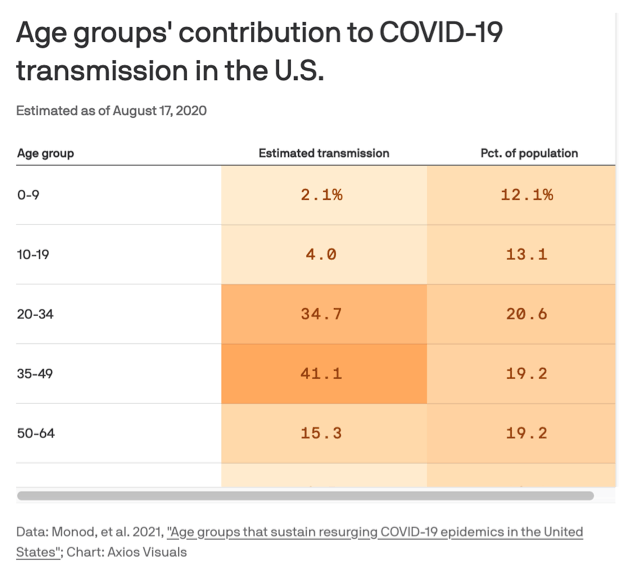| |
Young and middle-aged adults responsible for most COVID spread
|
| |
| |
Download the PDF here
https://www.axios.com/young-adults-coronavirus-spread-a998cf65-fcf3-472b-a1ed-e29938356351.html?utm_campaign=organic&utm_medium=socialshare&utm_source=twitter
The coronavirus pandemic in the U.S. has been chiefly driven by young and middle-aged people, while killing mostly older people.

----------------------------------------
Research Article
However, since children and teens seed infections in older age groups that are more transmission efficient, as of October 2020, school opening is associated with an estimated 25.7% [14.5%-40.5%] increase of COVID-19 infections and a 5.9% [3.4%-9.3%] increase in COVID-19 attributable deaths (table S7).
Larger proportions of COVID-19 infections and deaths are attributed to school re-openings if the actual number of cases among school-aged children is more than six times larger than the number in school situation reports (table S7). These findings indicate that adults aged 20-34 and 3549 continue to be the only age groups that contribute disproportionally to COVID-19 spread relative to their size in the population (fig. S14), and that the impact of school reopening on resurgent COVID-19 is mitigated most effectively by strengthening disease control to adults aged 20-49.
Conclusions
This study provides evidence that the resurgent COVID-19 epidemics in the US in 2020 have been driven by adults aged 20-49, and in particular adults aged 35-49, before and after school reopening. Unlike pandemic flu, these adults accounted after school reopening in October, 2020 for an estimated 72.2% [68.6%-75.9%] of SARS-CoV-2 infections in the US locations considered, whereas less than 5% originated from children aged 0-9 and less than 10% from teens aged 10-19. The population mobility data, and the death data provided by state and city Departments of Health reveal heterogeneous disease spread in the US, with higher transmission risk per venue visit attributed to individuals aged 20-49 over distinct time periods, and younger epidemics with a greater share of individuals aged 20-34 among cumulated infections in the South, South-western, and Western regions of the US. Over time, the share of age groups among reported deaths has been remarkably constant, suggesting that young adults are unlikely to have been the primary source of resurgent epidemics since summer 2020, and that instead changes in mobility and behavior among the broader group of adults aged 20-49 underlie resurgent COVID-19 in the US in 2020. This study indicates that in locations where novel highly-transmissible SARS-CoV-2 lineages have not yet established, additional interventions among adults aged 20-49, such as mass vaccination with transmission-blocking vaccines, could bring resurgent COVID-19 epidemics under control and avert deaths.
Age groups that sustain resurging COVID-19 epidemics in the United States
Science 02 Feb 2021
Abstract
Following initial declines, in mid 2020 a resurgence in transmission of novel coronavirus disease (COVID-19) occurred in the US and Europe. As COVID19 disease control efforts are re-intensified, understanding the age demographics driving transmission and how these affect the loosening of interventions is crucial. We analyze aggregated, age-specific mobility trends from more than 10 million individuals in the US and link these mechanistically to age-specific COVID-19 mortality data. We estimate that as of October 2020, individuals aged 20-49 are the only age groups sustaining resurgent SARS-CoV-2 transmission with reproduction numbers well above one, and that at least 65 of 100 COVID-19 infections originate from individuals aged 20-49 in the US. Targeting interventions - including transmission-blocking vaccines - to adults aged 20-49 is an important consideration in halting resurgent epidemics and preventing COVID-19-attributable deaths.
SARS-CoV-2 transmission is sustained primarily from age groups 20-49
Figure 3 summarizes the epidemic situation for all states and metropolitan areas evaluated, and the age groups that sustain COVID-19 spread. In the last observation week in October 2020, the estimated reproduction number across all locations evaluated was highest from individuals aged 35-49 (1.39 [1.34-1.44]) and 20-34 (1.29 [1.24-1.36]), and around one for age groups 1019 and 50-64 (tables S1 and S2).
Across all locations evaluated, we estimate that until mid-August 2020, before schools were considered to re-open in the first locations in the model, the percent contribution to onward spread was 41.1% [40.7%-41.4%] from individuals aged 35-49, compared to 2.1% [1.6%-2.8%] from individuals aged 0-9, 4.0% [3.5%-4.6%] from individuals aged 10-19, 34.7% [33.9%-35.5%] from individuals aged 20-34, 15.3% [14.8%-15.8%] from individuals aged 50-64, 2.5% [2.2%-2.9%] from individuals aged 65-79 age group, and 0.3% [0.3%-0.3%] from individuals aged 80+ (table S4). Spatially, the contribution of adults aged 35-49 were estimated to be remarkably homogeneous across states, whereas the estimated contributions of young adults aged 20-34 to COVID-19 spread tended to be higher in Southern, South-western, and Western regions of the US (Fig. 4), in line with previous observations (4).
|
|
| |
| |
|
|
|